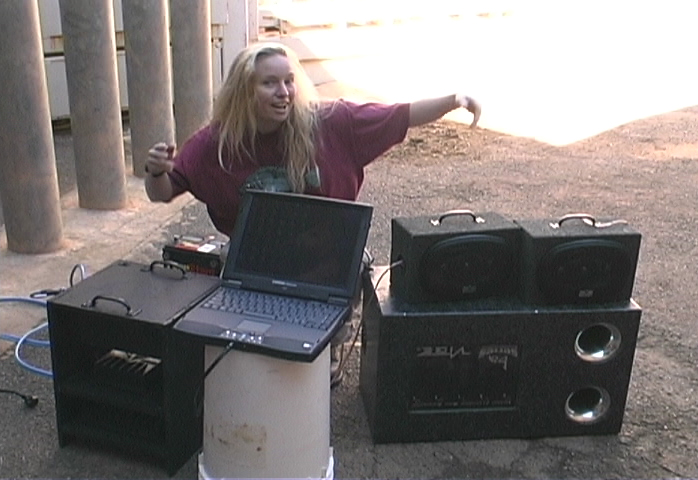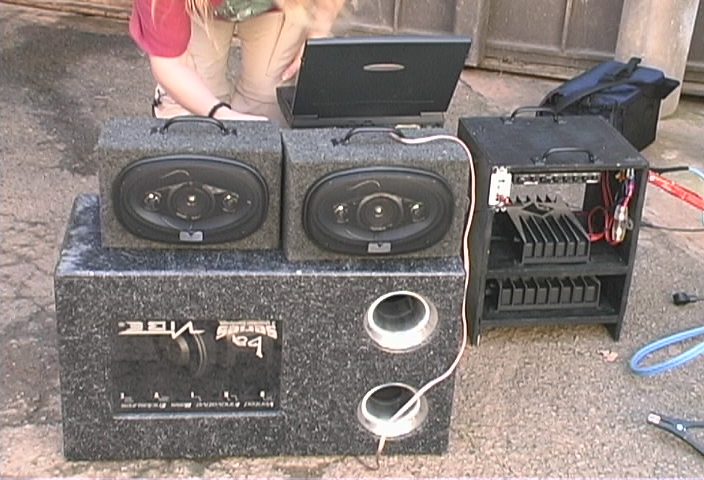Elizabeth von Muggenthaler - 919-732-1322, fauna@rtpnc.net
Fauna Communications Research Institute
North Carolina
Popular version of paper 4aAB2
Presented Thursday Morning, December 7, 2000
ASA/NOISE-CON 2000 Meeting, Newport Beach, CA
Throughout human history, science has been dependent largely on our ability to measure our natural world. Without the gizmos and gadgets we use to measure things, science as we know it would not be possible. Bioacousticians, or scientists who study animal communication, aim to understand more about a particular animal's behavior, and like other scientists, rely on technology to do so. To understand animal vocalizations, these scientists have to be able to measure the frequency (pitch), amplitude (loudness) and the length of time of animal vocalizations, as well as record the sounds and sometimes play them back to the animals.
The study of animal communication, as with any science, is fraught with complications. Not only are animals unpredictable, but also most animals have a greater range of both hearing and communication than we do. Humans can hear from 20-20,000 hertz, or cycles per second. Many animals are capable of communicating below and above this range. Sound below our hearing range (below 20 hertz) is called infrasound. Infrasound consists of low-pitched sounds like those that come from a bass or sub-woofer audio speaker. Infrasound can travel for long distances and go through objects, including buildings, forests, and in some cases even mountains.
Several species of animals are capable of communicating at these low frequencies. Elephants, whales, hippos, rhinoceros, giraffe, okapi, and alligator are just a few examples of animals that create infrasound. There are many more animals that are suspected of creating infrasound and are just waiting to be researched. Until recently, due to the lack of sophisticated technology, many bio-acousticians were forced to study animal sounds only within the human hearing range. This means that the scientists were only learning about half of the animal's actual communication. In human terms this would be as if we learned only of a foreign language, which would make us completely unable to understand that language.
In the past, the study of animal communication, especially in the wild, was hindered by the lack of portable equipment necessary for the research. Just ten years ago researchers were using 14 pound reel-to-reel recorders, and were virtually unable to do sophisticated analysis of the signals except by the use of spectrograms, a science developed after WWII. The study of sounds above or below the human range was almost impossible.
Within the past 15 years, the field of animal bioacoustics has developed the ability to produce more timely and accurate results than ever before, due to significant advances in technology. The digital audio recorder, or DAT recorder, some weighing less than of a pound, enabled easier and better recording in the field. Analysis programs to measure the frequency, amplitude and time of animal sounds was enabled by the development of software programs such as Canary, Signal and Avisoft. Unfortunately, these programs could not be performed in the field, because they were dependant on large signal processing boards designed for desktop computers. The animal's sounds could not be reliably analyzed in real-time, while the animal was being recorded. Additionally, the playback of animal sounds was cumbersome and in the case of infrasound, impractical, and sometimes impossible to perform.
Recently the portable computer enabled researchers to perform analysis in the field, but only within the human hearing range, because the signal processing boards were still too large for the portable computers. This meant, once again, that only about half of the animals' repertoire of sounds was being studied. Studying these low-frequency sounds in the field was impossible because the technology simply was not obtainable. In 1999, due to significant advances in the music and test/measurement industries, the technology finally became available to record, analyze and playback (in real-time) animal sounds including infrasound, in the field.
A system was designed to record sounds from 3 Hz to 22,000 Hz using Audio-Technica microphones and DAT recorders. Field analysis in this range was enabled by using National Instrument's DAQ card, a small PCMCIA math card that could fit inside a portable computer. National instruments and Microcraft designed a computer software program that could study animal sounds in real-time, with the added features of being able to save the sounds to hard drive, and to edit them, which is called a cut-and-paste function. By using marine batteries, V-I-B-E and Kenwood car audio speakers, and Rockford Fosgate amplifiers, the sounds were able to be played back in the field without difficulty.
Because of the recent advances in measuring devices, the study of bio-acoustics has reached a point at which researchers are capable of recording, analyzing, and playing back animal sounds virtually anywhere, anytime and in most any conditions. Humans tend to equate language with intelligence, if the world understood just how much these animals are communicating, perhaps humans will do more to protect these amazing, and often endangered, creatures.
Listen to sample of a lion's roar

